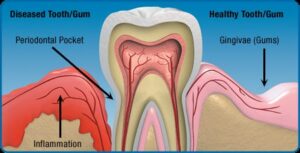
Bleeding gums are not that big of a deal
One important sign of periodontal disease (also known as gum disease) is red, swollen and bleeding gums. This is typically noticed when brushing, flossing, or eating certain foods. If you experience any of these symptoms during any of the mentioned activities, schedule an appointment as soon as possible to be evaluated by your dentist for periodontal disease.
Flossing every day is not necessary
The idea that flossing each day is not necessary is completely false. Your daily at-home dental care routine should consist of brushing at least twice per day and flossing at least once per day. While it is a proven method in the prevention of gum disease and gum recession, less than 15% of Americans floss every day. Contact your dentist or our office to see if a consultation with a periodontist is right for you.
Once you lose a tooth to gum disease, it’s lost forever
Tooth loss from complications of gum disease is more common than you think. However, the loss of a tooth does not mean it cannot be replaced. Custom treatment plans are offered to manage the disease. Dental implants are becoming increasingly popular as a favorable way to permanently replace missing teeth. A dental implant is an artificial tooth root that is implanted into the jaw as a replacement for a missing tooth. Most dental implants are created to match the rest of your teeth and have a 98% success rate.
Gum disease is only caused by poor oral hygiene
Poor oral hygiene can accelerate the development of gum disease, but it is not the only way to get it. Other things such as genetics, gum disease can be caused by stress, poor diet, tobacco, and bruxism. Bruxism, or chronic teeth-grinding, puts a large amount of pressure on the gums, causing them to retreat. Damage can be reduced with the use of an appliance such as a mouth guard when sleeping.
No cavities means no gum disease
While being cavity-free is great, it doesn’t mean you aren’t still at risk for gum disease. The symptoms of gum disease are often overlooked because many times there is no pain associated with it. Gingivitis, the earliest stage of gum disease, occurs when the gums are red, swollen or tender. When caught soon enough, gingivitis can be treated with a professional dental cleaning followed by daily brushing and flossing.
Are you curious about the health of your gums? By now, you should have a better understanding of what gum disease is and the truth about how to treat and prevent it. Even though the team at Race Orthodontics is in the business of straightening teeth and providing beautiful smiles, maintaining healthy gums is important. So see your dentist on a regular basis and if you have any questions please contact our Brookfield or Mukwonago WI office to schedule a complimentary initial consultation if you would like to learn more about getting a great smile.
Your healthy smile will thank you later.







